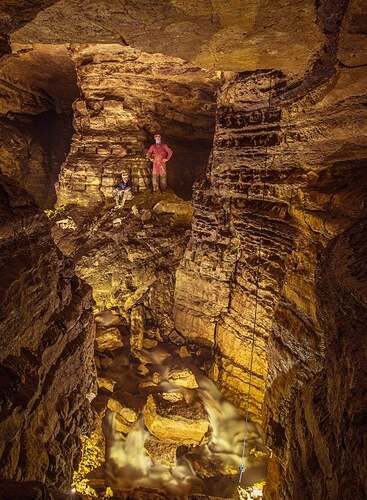List members , now this sure is interesting...hmmm...very interesting indeed ! What might be John Ackerman's ultimate objective ? Would he be willing to help our group's research ? I think it's worth exploring...
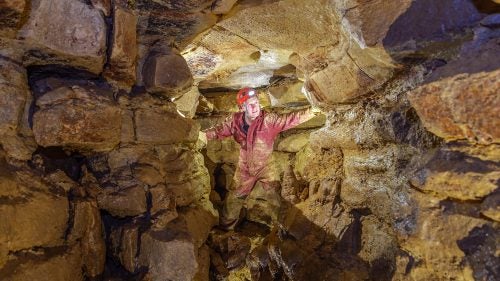
The Cave Kingpin Buying Up America’s Underground
Jun 17, 2020
John Ackerman has spent millions procuring a majority of the known caves in Minnesota, which add up to dozens of miles of underground passageways and likely make him the largest cave owner in the U.S. He collects and charts them in the name of preservation, but his controversial methods have created many opponents.
The cave’s entrance was a rusting, three-foot-tall, red casing pipe rising out of the ground behind a Minnesota farmhouse, surrounded by a quiet, flat stretch of prairie grass. Just 2.5 feet across, it was topped with a green, diamond-plated steel cover and might easily have been mistaken for a well or a piece of farm equipment rather than the mouth of a 120-foot shaft leading into some five miles of subterranean passageways. The cave’s owner, a furniture-restoration specialist named John Ackerman, pulled a hefty ring of keys from his pocket, unfastened the padlock, and swiveled open the lid, revealing a ladder bolted precariously to the wall of the opening, which disappeared into blackness only ten feet down. From the surface, I could hear the sound of distant, surging water.
Ackerman is 66, but except for the presence of a very subtle hearing aid, he looks 10 or 15 years younger, with intensely blue eyes and the handsome face of a local news anchor. His hands are massive and weathered, which made me slightly nervous each time we shook, and he speaks with a lack of affect that projects supreme confidence. He was, in short, someone with whom I felt perfectly comfortable descending 12 stories through a hole in the middle of a Minnesota field. Following his lead, I clambered over the rim of the shaft and started slowly climbing down into Tyson Spring Cave.
Ten minutes later, I landed on the bank of a subterranean river, its waters a chilly 48 degrees, corresponding precisely to the surrounding air. Ackerman began to guide me, midstream, through the central passage; the water was ankle-deep at first, then, a few steps later, it rose to our chests. Broad stretches of the cave’s walls, floor, and ceiling were marked by formations—flowstone, helictites, rimstone dams—that looked like the kind of Gothic ornamentation advertised by roadside commercial caves and from which visitors are normally required to keep their distance.
While much of the river was placid, certain sections were more turbulent, the water wending its way down sudden drops and around piles of cyclopean limestone boulders. Glinting in the light of my headlamp, a small aggregation of foam—the product of nitrogen leaking into the cave system from nearby farms—was the only sign of human presence. When I asked Ackerman how many people he allows into the cavern each year, he held up an outspread hand. “Fewer than I can count here,” he said.
Some distance into the cave, Ackerman stooped over to pluck a small bone from a dark alcove and then placed it daintily on a ledge. He told me he planned to send it, as he does all the bones that frequently turn up in Tyson Spring Cave, to the Science Museum of Minnesota, in Saint Paul. Occasionally, Ackerman’s finds prove significant: in 2008, a pair of prehistoric antlers he happened upon in the cave were determined to be the first evidence of the long-extinct stag moose in the state. The discovery of a saber-toothed tiger skull in a nearby passage that same year shifted estimates of the creature’s range some 600 miles north. Around us, undoubtedly, were plenty of other paleontological curiosities, but Ackerman had yet to survey the entire cave—he didn’t even know how big it was, let alone what might be hidden within.
That day I saw only a fraction of what Ackerman had explored in Tyson Spring. He told me of other distant caverns, more spectacular than anything I’d seen—elaborate and dense arrays of formations, vaulted rooms as large as single-family homes. “If you could see the entirety of the cave,” Ackerman said, “you’d think, One person shouldn’t own this.”
Matthew Sherrill is a deputy editor at Harper’s Magazine.
Previous
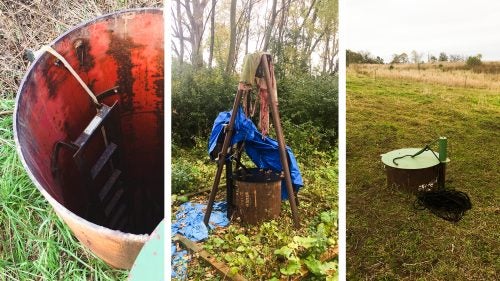
From left: the entrances to Tyson Spring Cave, Fountain Spring Cave, and Holy Grail Cave (Matthew Sherrill)
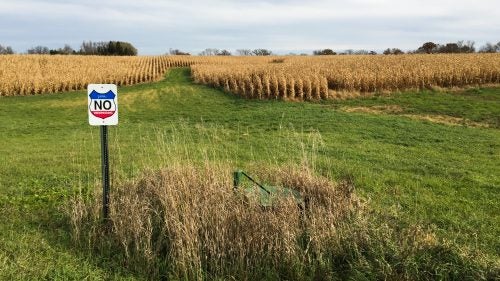
The entrance to Bat River Cave (Matthew Sherrill)

From left: the entrances to Tyson Spring Cave, Fountain Spring Cave, and Holy Grail Cave (Matthew Sherrill)

The entrance to Bat River Cave (Matthew Sherrill)

From left: the entrances to Tyson Spring Cave, Fountain Spring Cave, and Holy Grail Cave (Matthew Sherrill)
Next
Tyson Spring Cave is but a tiny portion of Ackerman’s underground empire. In his more than three decades of subsurface prospecting, using wealth accumulated from his furniture-restoration business, he has purchased some 40 miles of cave passages, the vast majority of those known to exist in Minnesota. Collectively, they amount to what he calls the Minnesota Cave Preserve. As far as anyone seems to know, he’s the largest private cave owner in the United States.
Ackerman’s procurement method is simple: scout out terrain where he’s heard rumors of caves or where their presence is geologically probable. If he finds a cave, or convincing evidence of one, he’ll negotiate with the landowner for subterranean rights to the property it’s under and then offer to buy outright the small plot of land that contains the entrance—usually around two or three acres. If the natural entrance is particularly dangerous or inaccessible, he’ll purchase a parcel of land above a connecting cave passage and drill his way in, installing a version of the sewer-type shaft I saw at Tyson Spring.
Enchanted by caves since his youth, Ackerman says he’s driven by a spirit of preservation, and he alleges that Minnesota’s Department of Natural Resources—which he’s battled for years over access to some of the state’s most magnificent caverns—is neither willing nor financially able to stake out new caves or properly manage those already discovered. While the DNR favors a fairly passive conservation policy and is more invested in the careful supervision of known caverns than in searching for new ones, Ackerman embraces a more aggressive approach and believes that it’s his responsibility to find and secure as many caves as possible for posterity. His motto: “You can’t protect what you don’t know exists.” It’s a saying that manages to convey both boilerplate environmentalism and an imperial sense of mission.
As a confrontation-prone semi-urbanite intent on snatching up every piece of choice subterranean Minnesotan real estate he can find, Ackerman has attracted both skepticism and outright hostility. The DNR and other cavers have faulted him for what they see as an overly domineering attitude; they criticize him for regarding the entire subterranean landscape as rightfully his and bemoan the fact that he can seemingly buy his way into any cave he wants. Local farmers have chased him off their land, regarding him as some odd, spelunking carpetbagger. And yet, Ackerman continues to seek out new caves undeterred, always looking to add mileage to the preserve. It’s not easy, after all, to responsibly tend to the last uncharted regions of the earth—to administer the underworld.
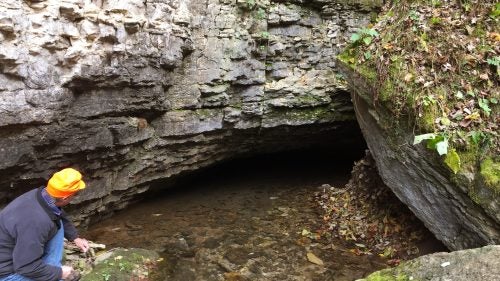
Ackerman at the natural entrance to Tyson Spring Cave (Matthew Sherrill)
The better part of Ackerman’s territory is located beneath Fillmore County, a land of 20,000 people and several hundred caves. It’s part of the so-called Driftless Area, a region stretching some 24,000 square miles across parts of Minnesota, Iowa, Wisconsin, and Illinois. For reasons geologists don’t entirely understand, the area remained free of glaciation during the last Ice Age, leaving its porous limestone and dolomite uncovered by glacial sediment, or “drift.” It’s what’s known as a karst landscape, an immense labyrinth of caverns disguised only by a thin layer of soluble rock and loess.
Traveling south from the Twin Cities, you see the transition into the Driftless written on the surface. The strict, Cartesian grid of county roads typical of the Midwest begins to warp and skew. Cornfields yield to densely forested hills, limestone escarpments burst from the roadside, and the intervening plains are increasingly marked by gullies and hollows. Broad swaths of countryside are riddled with sinkholes, which implode every so often to swallow livestock and give farmers headaches. Driving the Driftless, I could mark them from the road—clusters of trees and brush in otherwise cultivated fields. Many such sinkholes served as refuse heaps for 19th-century farmers and to this day are filled with decomposing appliances and machine parts. Every one of them leads to a cave.
Ackerman grew up in Burnsville, a drab suburb of Minneapolis that’s about 25 miles from the edge of the Driftless. He majored in law enforcement in college, intending to be a cop—a highway patrolman, specifically—but he narrowly missed the cut on his exams, and he rejected an offer he received to serve as police chief somewhere small and out-of-the-way. Instead Ackerman opted to follow a long-standing family tradition, starting a furniture-restoration company named Ackerman’s Furniture Service out of his parents’ garage.
His motto: “You can’t protect what you don’t know exists.” It’s a saying that manages to convey both boilerplate environmentalism and an imperial sense of mission.
As the business grew in the 1980s, Ackerman met a caver named Dave Gerboth, who first introduced him to the geology of southeastern Minnesota. During his teenage years, Ackerman had spent much of his time reconnoitering the abandoned sandstone mines around Saint Paul, and he found himself hunting down local caverns or derelict quarries whenever he traveled out of state. But he never realized what awaited him in the Driftless, so close to his hometown, until he met Gerboth. In thrall to the romance of exploration, the two began spending weekends searching for caves, then surveying and mapping their reach. Gerboth served as the technical mastermind behind the operation—the “bean counter,” as Ackerman called him—while Ackerman assumed the role of the daring, if sometimes impulsive, physical risk-taker.
In 1989, Ackerman made his first acquisition: Spring Valley Caverns, whose passages he and Gerboth expanded by five miles with explosive charges, a common tactic for widening narrow crevasses or punching one’s way into fresh caves. Ackerman owns both a federal explosives license from the Bureau of Alcohol, Tobacco, Firearms, and Explosives (ATF) and a conditional-use permit granted by Fillmore County’s zoning office, allowing him to blast throughout his passageways as he sees fit. In order to meet the stringent requirements governing storage of the materials, he keeps them in one of his caves.
Caver Kirk Moorhead (left) and Ackerman in Holy Grail Cave in 2017 (Courtesy Martin Larsen)
Most of the time, Ackerman’s cave system will wind beneath the property for which he owns subterranean rights, but if it does veer across the border, Ackerman says neither he nor the neighboring property owner is likely to realize or care, since the caverns are not being commercially developed. His explosives, however, have caused issues. A fisherman near Spring Valley Caverns once complained to him that the explosions were causing the water in a nearby trout stream to slosh back and forth like a wave pool. A woman in a neighboring farmhouse mentioned to him that frequent rattling from blasts had broken a healthy portion of her mother’s antique china collection. Ackerman says he now uses a drill to open caves and employs explosives only to create new passageways.
Spring Valley Caverns was followed by a number of other additions, among them Cold Water Cave in 2003, Tyson Spring Cave in 2006, and Bat River Cave in 2007. While Ackerman doesn’t like talking about money, he acknowledged that in building the preserve, he’s probably spent some $4 million on land, equipment, and maintenance.
But Spring Valley, in the northwest corner of the Driftless, remains the heart of Ackerman’s holdings, lying in the midst of a 700-acre tract of prairie grass, forest, and fields of alfalfa and no-till corn that he calls the Cave Farm. After a day of caving in October, he took me on an exhaustive tour of the grounds, which contain no fewer than 36 caves, among them Hidden Cave, Narrow Crevice Cave, Artifact Cave East, Artifact Cave West, Temple of Doom Cave, the Big One, and No Name Cave. Some are little more than exaggerated hollows, while others are so large that their full extent remains unknown. The borders of the estate, marked with red, white, and blue signs resembling U.S. interstate shields, read “No Tresspassing.” A much smaller fragment of text at the top announces: “Minnesota Karst Preserve.” (Some signs say “Minnesota Cave Preserve” instead—Ackerman changed the name after realizing that very few people knew what “karst” meant.)
On one end of the property, a barn contains Ackerman’s heavy machinery—a Bobcat loader and a modified hydraulic excavator with the words “Cave Finder” printed across the boom. At the other end is the main entrance to Spring Valley Caverns, an unpretentious limestone facade built into the side of a hill. Inside is what amounts to the de facto clubhouse of Ackerman’s Minnesota Caving Club, where its 15 or so active members can prepare for expeditions, store gear, or sleep.
Before Ackerman bought Spring Valley Caverns, its owners briefly operated it as a commercial cave open to the public. Accordingly, there’s far more infrastructure here than in Ackerman’s other caves—steel walkways, concrete slabs—which makes it a bit friendlier to non-cavers, though all this comes at the cost of a certain amount of preservationist purity. Not that Ackerman would ever call himself a purist—developing each of his caves has involved excavation, dirt clearing, debris removal, and, of course, blasting. He needs to find a way in, after all. You can’t protect what you don’t know exists.
Puttering around the Cave Farm in Ackerman’s van that day, I asked him whether he had ever found a cave and then failed to acquire it. “I can’t think of a cave I’ve discovered and lost,” he said, then paused and reconsidered. It turned out that there was one cave. The landowner agreed to let Ackerman survey the land and drill his way in, but Ackerman had trouble locating the system from the surface. Eventually, he realized he’d been surveying an area a mere 50 feet from the cave, but by that time the owner had changed his mind and refused to sell. Ackerman hasn’t given up. “If the owner dies,” he said, “hopefully I have a chance at it.”
On an unpleasant, damp Saturday in late October, Ackerman and I drove through Fillmore County in his van, stocked with helmets, gloves, headlamps, cave suits, boots, arm pads, kneepads, and wetsuits, along with an assortment of ropes and harnesses that I hoped we wouldn’t be using. Our destination was Holy Grail Cave, whose exact location I didn’t yet know. The sites of Ackerman’s cave entrances are kept largely under wraps, though some of these secrets are more closely guarded than others. The basic principle is that unwanted attention can lead to unwanted visitors, and unwanted visitors can lead to irreparable, if inadvertent, damage. Accordingly, entrance to the caves, while free of cost, requires Ackerman’s permission, as well as the hiring of a sanctioned guide and the signing of an ominous waiver that itemizes 23 distinct risks one might face underground. (The more casual spelunker can opt for the state-run Mystery Cave or tours of the nearby, privately operated Niagara Cave.)
Eventually, we pulled over at an Amish farm across the street from a field that contained the Holy Grail entrance. Ackerman had been leasing his plot to the farmer and needed to finalize some paperwork, as well as have a firm conversation about overgrazing that had reduced one corner of the land to a sad patch of dirt.
After steady rains, the driveway and surrounding grounds had been churned into a deep, viscous muck. A few chickens strutted around the decaying silos and rusted-out farm implements, and a rangy dog, one hind leg hopelessly mangled, hobbled forth to greet Ackerman as he stepped out of the van. As it happened, a disheveled, heavyset neighbor in paint-spattered jeans was also waiting to visit with the farmer. They spent a few minutes in friendly conversation before I heard Ackerman say, “You know, I own the cave across the street.” He proceeded through a few caving anecdotes before asking about the man’s own tract of land. “Are there sinkholes on the property?” It turned out there were two. Ackerman darted back to the van, where I already had his business card ready, and returned to the neighbor, now a promising, potential new conduit to imperial expansion. “Here,” Ackerman said, handing him the card. “Just call me.”
Once we had crossed back over the county road, I discovered that the entrance to Holy Grail was, like the way into Tyson Spring, a lidded, three-foot-wide metal culvert pipe poking inconspicuously out of the earth in the far corner of a field. Once again there was a padlock, the only visible security measure, dangling from the exterior of the shaft, so I asked the obvious: What’s to stop a prankster, or one of the myriad enemies Ackerman had made over the years, from securing the lock and forever consigning him to his own sunken empire?
“Aha,” he replied. “Watch.” He leaned over and showed me a mechanism on the shaft’s interior. Swiveling two levers, he demonstrated how the entire locking component would then fall away, freeing whomever might be trapped inside. “It was one of the first things I thought of.”
Down below, southern Minnesota’s wettest year on record had left every surface of Holy Grail plastered in several inches of mud. As a relative spelunking novice, I found myself spending much of the time yanking my boots out of particularly deep patches or clawing desperately at anything dry to anchor myself on the cave’s slippery slopes. Ackerman—some 30 years my senior—was scampering up inclines and over rubble with ease, never seeming to falter. He knew the rock’s nuances, a kind of second-nature response to each challenge it presented. He stayed relatively clean; I began to grow less and less distinguishable from the mud-coated features around me.
Not that Ackerman would ever call himself a purist—developing each of his caves has involved excavation, dirt clearing, debris removal, and, of course, blasting.
During one merciful breather, Ackerman indicated a narrow chasm, tossing a rock down to give a sense of its depth. We heard it land four seconds later, clattering between the side walls before plunking into a pool of distant water. Years ago, on an early expedition into Holy Grail with two fellow cavers, Ackerman had ventured alone into the pit, suspecting that it might lead to another navigable passage. He braced himself between the walls, without a rope or harness, and wiggled his way down to a chockstone—a fallen hunk of rock nestled snugly across the shaft. It collapsed. Still wedged above the abyss, he maneuvered down to another chockstone, which also gave way beneath his weight. In the ensuing scramble to stay aloft, he lost his headlamp, leaving him in darkness.
“I heard them say, ‘Is he dead?’” Ackerman recalled. Realizing their mistake, his partners tossed him some nylon webbing, and he was able to climb his way back to safety unscathed.
Ackerman is prone to businesslike narration of such near death experiences. There was the time he almost brought several tons of rock down on his head while experimenting with Kinepak explosives in Spring Valley Caverns. There was the time he almost drowned in a cave after whitewater surged through its tunnels during a sudden deluge. There were the several times that he found himself hopelessly lost in his own caves for hours and had to leave blasting wire on the walls, shaped like arrows, to avoid retracing his own steps as he searched for a way out. And then there was the time in Granger Cave that he dove into a sump—a water-filled passage—carrying an oxygen tank in one arm, got tangled up in his dive line, lost his weight belt, cracked his head against the cave ceiling, and finally broke himself free with a line cutter and managed to blindly navigate the inky waters back to dry rock after some 35 minutes of composed panic.
He tells these stories less to impress, I think, than to remind himself of the sheer strangeness of his vocation. And perhaps more importantly, to reassure himself of his identity as the elect, proper steward of the Driftless underground.
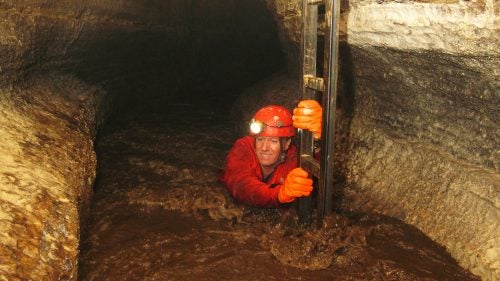
Ackerman in Bat River Cave in 2007 (Courtesy Jim Edberg)
More than three decades of tenacious cave chasing have garnered Ackerman a not undeserved reputation for combativeness and obstinance. There were recurring themes in conversations I had with other members of the Minnesota caving community: that Ackerman was too reckless in his use of explosives and heavy machinery; that he was overly discriminatory about who he allowed into his caves; that these decisions were sometimes governed by petty, personal animus; and that even as he restricted entry to his own caves, he seemed to think he was entitled to explore those belonging to others. (Ackerman denies ever being motivated by anything personal.) “He feels that he should have the right to go anyplace he wants to go, because he has the money to do so,” one caver told me. “That’s what bothers me with his approach.”
His aggressive tactics climaxed in the late eighties when Mystery Cave—at 13 miles, the longest cave in the state—came up for sale by its owner. The DNR, which at that point didn’t own a single cave accessible to the public for tours, began to express interest, mounting a massive public-relations campaign to argue that the expenditure was worthwhile, and at one point even enlisting a few local radio hosts to broadcast from the cave to drum up support.
Fearing that the DNR would limit the access he’d been given to the more far-flung corners of Mystery, Ackerman made a desperate offer to the landowner, begging him to sell it to him. But the owner opted to take the DNR’s bid of $350,000, and the state took control in 1988. Officials promptly saddled Ackerman and other cavers with prohibitive restrictions and regulations, effectively keeping him out of the less charted areas, despite his claims to have been on the verge of discovering a promising series of new passageways.
These rules were eventually relaxed, and Dawn Ryan, the current DNR park manager at Mystery Cave, made clear to me that Ackerman is perfectly welcome to visit mapped regions of the cave today, as long as he files an appropriate request with the state. Ackerman, however, insists that he still can’t gain access to explore the system’s uncharted areas.
The spat over Mystery Cave inaugurated a long, bitter war between Ackerman and the DNR. In 2000, the agency acquired the natural entrance to Goliath’s Cave, a two-mile system that local cavers had been exploring for more than 15 years. A steel gate was installed, forbidding entry to all save those who the DNR had granted permits. But the state government hadn’t obtained subsurface rights for the entire cave, so Ackerman simply purchased a small plot of land from the adjacent landowner and bore his own way in. Signs confirming the entrances’ respective owners still face one another across a country road. In the midst of this squabble, Ackerman claims, the DNR convened a meeting in Saint Paul, where officials hung a giant banner reading: “He Must Be Stopped.” (The DNR says this is just a rumor.)
In recent years, tensions have cooled between Ackerman and the DNR, each adopting a kind of unofficial truce as Ackerman’s chief combatants have retired or moved on. But his rifts with certain elements in the local caving community persist, chief among them the Minnesota Speleological Survey (MSS), the local chapter of the National Speleological Society, the country’s preeminent caving organization. Ackerman became a member of the MSS in the early eighties, but by 1986, he began to sense that his fellow members were growing averse to his cavalier attitude. Increasingly convinced that MSS members were overly obsequious toward the DNR, and regarding them as unserious hobbyists, Ackerman ultimately formed his Minnesota Caving Club, which still functions on a kind of parallel track to the MSS.
“If you’re coming just to have fun, and not to actually work and contribute, that’s a big turnoff,” Minnesota Caving Club president Martin Larsen told me, in reference to the MSS. “If you’re just going to come, and you want to be on an adventure, so you can go tell a good story, then go be a rock climber or something.” The Minnesota Caving Club, he said, is all about “the discovery, documentation, the science, the protection.”
Current MSS members, of course, see their group as the more serious and dedicated of the two. “We’re much more interested in the surveying and the studying of the caves, more so than going on cave trips for pure fun,” said Nick Seaton, the MSS president. He gets along reasonably well with Ackerman, he said, but the long-standing acrimony between the clubs leaves the MSS with a relative dearth of caving opportunities. “He owns three-quarters of the caves in the state,” Seaton lamented. “I’m clearly the president of the enemy.”
Sitting in the offices of the Mystery Cave visitor center, I mentioned the Minnesota Cave Preserve to park manager Dawn Ryan, who raised an eyebrow and said, “Ackerman?” She didn’t sound angry, just disappointed, as though she were hoping for a neutral discussion of speleothems, cephalopod fossils, and white nose syndrome, only to realize that a Minnesota cave conversation had once again drifted inexorably toward him. “There are places that are better off left alone,” said Ryan, diplomatically. “And humans have a tough time doing that.”
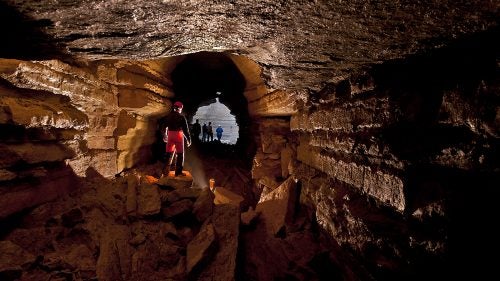
Spring Valley Caverns in 2011 (Courtesy Jim Edberg)
Ackerman’s Furniture Service, where he still spends much of his time, is situated off a frontage road in his hometown of Burnsville. The day I visited, the shop floor was swamped with ongoing restoration projects: Shaker chairs, curio cabinets, bookcases, and credenzas suffering from fire damage or salvaged from estate sales. Ackerman’s goal, he told me, was to “return them to brand-new condition—without having them look brand-new.” The repairs thus tended to take on a hybrid form: old components, carefully restored and refurbished to a suitable approximation of newness, augmented by new components, artificially weathered to a suitable approximation of oldness. “It’s a dying art,” he said.
Ackerman lamented the triumph of particle board and the disposable way in which people now typically regard their furnishings. His own home, where he lives with his girlfriend, is a sprawling country house with panoramic lake views, and it’s appointed tastefully with centuries-old restoration projects. (Ackerman is divorced, and his three children from that marriage are now adults.) The house and his work evince a fear of the past being lost or forgotten, as well as a kind of distaste for the relentless novelty demanded of modernity—an aversion that, in Ackerman’s case, seemed at turns aesthetic, curmudgeonly, and ecological.
“Screw growth,” he said during one drive, passing a garish new condo complex in the farmlands south of Minneapolis. His knowledge of the subterranean world had left him not only with a keen sense of the earth’s precariousness but also a deep geological perspective. Measured against the processes that form something like Tyson Spring Cave, suburban development was trivial.
The previous weekend, my excursion into Spring Valley Caverns had ended in a chamber Ackerman called the Resting Room. Blasted into one wall was a small recess, some eight feet deep. “This is where I will be buried,” he said with a smile. I took it as a joke at first, but as he began a detailed explanation of how his body would be ferried down into the cave, I realized that he was serious. In fact, Ackerman had already ordered a specially crafted coffin made of 14-gauge stainless steel from Coffin It Up, a custom casket manufacturer in Pahrump, Nevada. Like the cave empire itself, it was a curious blend of egotistical gall and honest reverence toward the realms of the underground.
Ackerman’s burial plans led me to think that his predilection for subsurface risk-taking had little to do with the thrill of tempting fate. He seemed more attracted by the atavistic lure of conquest, of mastering and laying claim to the unknown. On a hike we took to the natural entrance of Tyson Spring, a place Ackerman had been dozens of times before, he still scrambled to look at every geologically suspicious crevasse or opening for signs of airflow or tiny white spots of calcium—anything that might indicate the presence of virgin cave. For every tale I heard of derring-do, there was a story about stumbling upon pristine passages, about finding himself where no man had gone before.
“There are places that are better off left alone,” said Ryan, diplomatically. “And humans have a tough time doing that.”
In this sense, the way Ackerman talks about his ambitions and motivations sounds strangely anachronistic—it’s the language of classic exploration, of George Mallory, Robert Peary, even Neil Armstrong. A photograph of Ackerman posed imperiously in a chamber of Spring Valley Caverns is captioned “First Footprints.”
Perhaps it makes sense that this last vestige of undiscovered, unmapped territory is one of the last vestiges of this kind of thinking. But in his more reflective moments, Ackerman would just as quickly adopt the opposite position, assuming a tone of modesty and deference. “No one can really own a cave,” he told me. “I’m a temporary steward.” In these moments, he saw his endeavors as a kind of ethical obligation: “When you find a cave, you owe it to society to make a map of what you’ve found.”
Ackerman displayed an almost religious devotion to these fragile places and a certain sadness that far too few people seemed to share it, especially now that he’s getting old and the future of his domain is looking murky. His children have embarked on above-ground careers, with little interest in committing to the security, maintenance, and management of his below-ground assets. With no clear heir, and no one with the combined resources and dedication to preside over 40 miles of caves, Ackerman has considered putting the land in a trust, leaving it to his caving club, or even attempting to work something out with his longtime enemies at the DNR as a last-ditch option.
Idling outside Tyson Spring Cave, Ackerman told me a story about cavers from the University of Minnesota who he brought into the cavern several years ago. They needed a surveying project to complete their degrees, and Ackerman obliged. The cave needed mapping anyway. But a team member ended up accidentally breaking a formation, and large portions of the cave remained uncharted by the time they left, several years later. In one way, the incident affirmed Ackerman’s concerns about the hazards of open access, and yet he didn’t lay the blame on the surveyors. “Anything that happens is my fault,” he told me, referring to the formations. We were sitting in the van, staring out at a sweep of prairie concealing his underground domain. “It’s hard,” Ackerman said, sighing. “You don’t want to come across as a dictator.”
Regards


